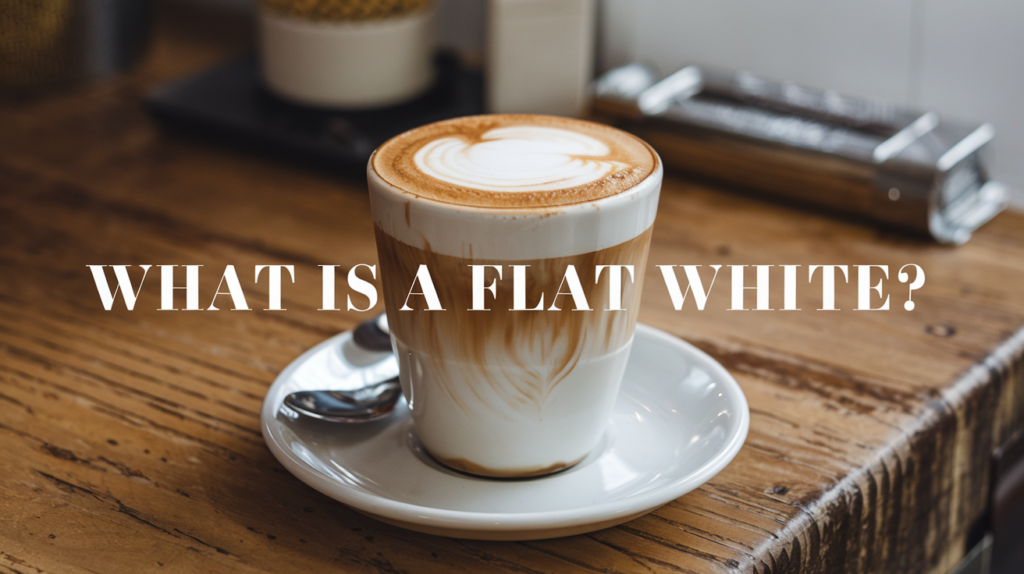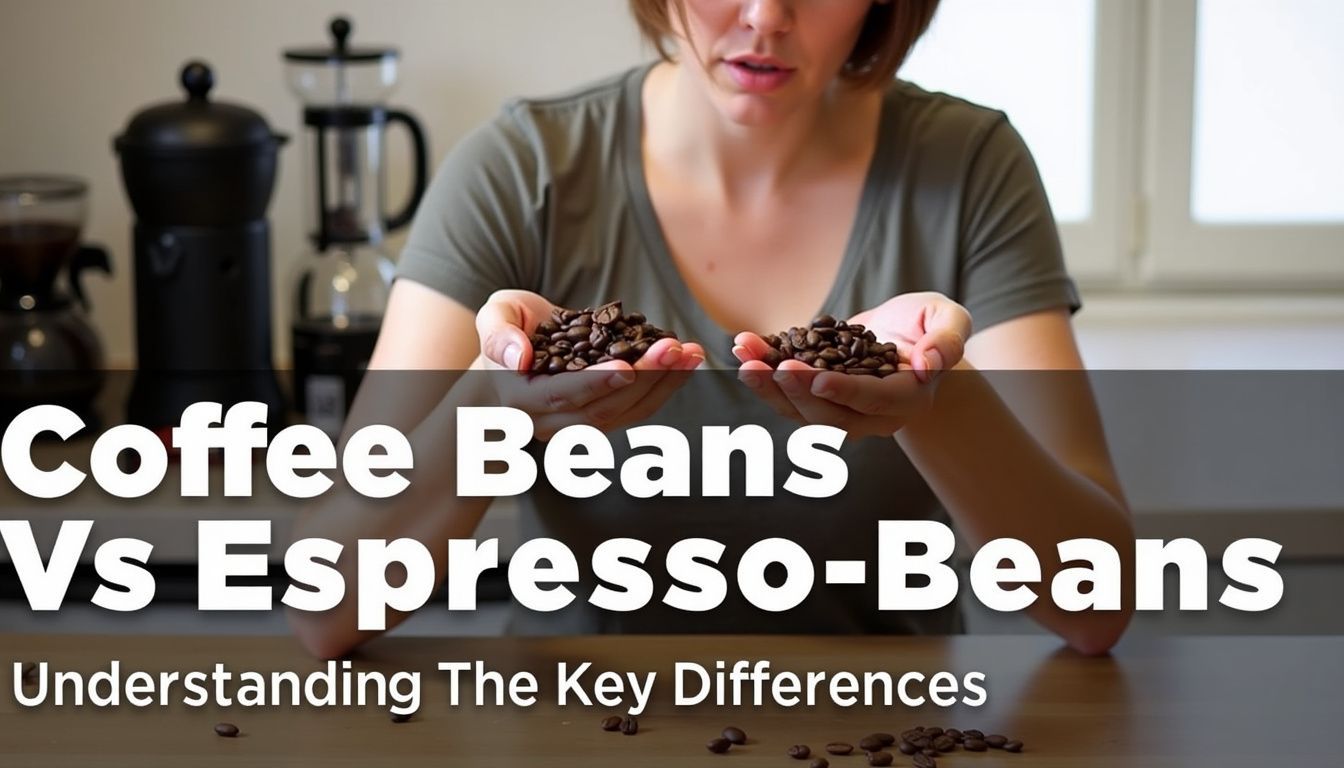Blog
What is a Flat White?
Ever wondered what a flat white is? You’re not alone. Many coffee lovers get confused by this drink. It’s not a latte, and it’s not a cappuccino. So, what is a flat white?
A flat white is a coffee drink made with espresso and steamed milk. It has more coffee than a latte but less foam than a cappuccino. This guide will show you how to make the perfect flat white at home.
You’ll learn about its history, how it’s made, and what makes it special. Ready to become a flat white expert?
What Is A Flat White Coffee?
A flat white is a coffee drink with a rich taste. It’s made with espresso and steamed milk, but with less foam than a latte.
Origins And History
The flat white’s origins are somewhat unclear. Both Australia and New Zealand claim to have created it first in the 1980s. This coffee drink emerged from a desire for something between a latte and a cappuccino.
Cafes in Sydney and Wellington both assert they served the first flat white. The discussion about its true inventor continues today.
Flat whites quickly gained popularity in Australian and New Zealand coffee shops. By the 1990s, they were widely enjoyed in these countries. The drink soon spread to the UK and other parts of the world.
Today, you can find flat whites in coffee shops globally. It has become a favourite choice for those seeking a strong, smooth coffee flavour.
Key Characteristics
Flat whites stand out with their smooth, velvety texture. You’ll find a rich espresso base topped with steamed milk. The milk is micro-foamed, giving it a silky feel. This drink has a higher coffee-to-milk ratio than a latte.
You’ll taste a stronger espresso flavour in every sip.
A flat white comes in a smaller cup, about 160-165ml. It’s often served in a tulip-shaped cup. The surface looks flat, hence the name. Baristas often add latte art on top. This drink blends the boldness of espresso with the creaminess of steamed milk perfectly.
Basic Components
A flat white has two main parts: espresso and microfoam milk. You’ll find a single or double shot of espresso at its base. This gives the drink its strong coffee taste. On top, there’s a layer of steamed milk with tiny bubbles.
This milk is called microfoam. It’s smooth and velvety, not frothy like in a cappuccino.
The size of a flat white matters too. You’ll usually get it in a 160-165ml cup. This size lets the coffee flavour shine through. The milk doesn’t overpower the espresso. That’s why many coffee lovers enjoy flat whites.
They offer a perfect mix of rich coffee and creamy milk.

How Does A Flat White Differ From Other Coffee Drinks?
A flat white stands out from other coffee drinks. It has less milk and a smoother texture than a latte or cappuccino.
Comparison With Latte
Flat whites and lattes share similarities, but key differences set them apart. Here’s a breakdown of how these two coffee drinks compare:
| Feature | Flat White | Latte |
|---|---|---|
| Coffee-to-milk ratio | Higher | Lower |
| Espresso flavour | Stronger | Milder |
| Serving size | 160-165ml | Larger |
| Milk texture | Velvety microfoam | More frothy |
| Milk temperature | Cooler | Hotter |
Flat whites offer a stronger coffee flavour. They use less milk, allowing the espresso to be more prominent. Lattes, conversely, have more milk. This results in a smoother and less intense taste. The size also differs. You’ll receive a smaller cup with a flat white. Lattes come in bigger servings. The milk in a flat white is silkier. Latte milk is frothier with more bubbles. Flat whites are served at a slightly lower temperature than lattes. This maintains the coffee’s bold taste.
Comparison With Cappuccino
Flat whites and cappuccinos differ in key ways. Here’s a quick comparison:
| Feature | Flat White | Cappuccino |
|---|---|---|
| Milk texture | Silky, smooth microfoam | Thick, frothy foam |
| Coffee-to-milk ratio | Higher | Lower |
| Espresso flavour | Stronger | Milder |
| Serving size | Smaller, tulip cup | Larger cup |
| Milk steaming | Focused on microfoam | Creates frothy layer |
| Overall taste | Balanced blend | Layered structure |
| Mouthfeel | Smoother | Frothier |
You can observe the flat white’s smoother texture and stronger coffee taste. Its microfoam provides a silky feel, unlike the cappuccino’s frothy top. The flat white offers more espresso flavour in a smaller cup. Cappuccinos present a layered drink with a frothy cap. Your choice depends on whether you prefer a stronger coffee flavour or a frothier sip.
Difference In Milk Texture
Milk texture distinguishes flat whites from other coffee drinks. In a flat white, you’ll find silky, micro-foamed milk. This milk has tiny bubbles that give it a smooth, velvety feel.
It’s thinner and shinier than the milk in a latte.
Flat whites have less foam than cappuccinos. The layer of microfoam on top is thin, not thick. This allows you to taste more of the coffee’s flavour. The milk blends well with the espresso, creating a balanced drink.
You’ll notice the difference as soon as you take your first sip.

What Makes The Perfect Flat White?
A perfect flat white needs the right beans, milk ratio, temp, and foam. Want to know more? Keep reading!
Coffee Bean Selection
Coffee beans make or break your flat white. You need top-quality espresso beans for the best taste. House of Koko’s House Blend and Festive Blend work well. These give rich flavours like chocolate, caramel, fruit, and nuts.
Your flat white needs a 2-3 oz espresso shot. Pick beans that suit this size. Seasonal coffees can add new tastes to your drink. The roast style matters too. It changes how your flat white tastes in the end.
Milk To Coffee Ratio
The milk-to-coffee ratio in a flat white is key. You’ll find more coffee and less milk than in a latte. A perfect flat white has about 160-165ml total volume. This mix gives you a stronger coffee taste.
The exact ratio can change based on where you get your drink. Some cafes use more milk, others less. But the goal is always a bold coffee flavour with smooth milk.
Your flat white should have a higher coffee-to-milk ratio than a latte. This means you get more of that rich espresso taste in each sip. The milk adds a creamy texture without drowning out the coffee.
It’s a balance that makes the flat white unique among coffee drinks. You can ask your barista about their specific ratio if you’re curious.
Temperature Requirements
Flat whites need just the right heat. You want your milk at 60-65°C. This keeps the drink smooth and tasty. Too hot, and you’ll burn the milk. Too cool, and it won’t mix well with the coffee.
Baristas use special tools to get the temp spot-on. A good thermometer helps a lot. Some fancy coffee machines even have built-in sensors. These gadgets make sure every flat white comes out perfect.
Microfoam Technique
Microfoam is essential for a perfect flat white. You’ll need to steam milk properly to achieve that silky texture. Heat the milk to about 60°C and incorporate tiny air bubbles. This creates a smooth, glossy foam that’s neither too thick nor thin.
Pour it slowly over your espresso shot for the best results.
Perfecting microfoam requires practice. Begin with cold milk in a metal jug. Position the steam wand just below the surface to introduce air. Then, submerge it deeper to heat the milk evenly.
Swirl the jug to combine the foam and liquid milk. Tap out any large bubbles before pouring. With time, you’ll master this key flat white skill.

How Is A Flat White Prepared?
Making a flat white is an art. You need skill to get the right mix of espresso and silky milk.
Espresso Extraction
Espresso extraction forms the base of a flat white. You need a single or double shot of espresso, about 2-3 oz. The process starts with finely ground coffee beans packed into a portafilter.
Hot water is then forced through at high pressure. This creates a rich, concentrated coffee with a layer of crema on top. The quality of your espresso impacts the final taste of your flat white.
Use fresh, well-roasted beans for the best results.
Getting the right extraction is key. Too fast, and your espresso will be weak and sour. Too slow, and it’ll be bitter and over-extracted. Aim for a 25-30 second extraction time. The espresso should flow like warm honey, not gush or drip.
A good shot has a golden-brown crema and a balanced flavour. It’s this perfect espresso that gives a flat white its distinctive taste.
Milk Steaming Process
Steaming milk is key to a great flat white. You’ll need to create microfoam – tiny bubbles that give the milk a smooth, velvety texture. To do this, you’ll steam milk with air. It’s tricky to get right, so it’s best to learn from a pro in person.
Before you mix the milk and espresso, swirl the shot. This gets rid of any bubbles. Then, pour your steamed milk over the espresso. The result? A silky flat white with just the right balance of coffee and milk.
Pouring Technique
Preparing a flat white requires finesse. You need to pour the milk gradually into the espresso. Begin at the centre and progress outwards. This produces a seamless blend of coffee and milk.
The aim? A velvety consistency without bubbles.
For an excellent flat white, give the espresso a swirl first. This eliminates any air pockets. Then, slightly tilt your cup as you pour. Keep the spout near the surface. This technique also aids in creating latte art.
The correct pouring method results in the ideal 1:2 coffee-to-milk proportion.
Common Mistakes To Avoid
Flat white lovers often make mistakes that ruin their drink. Here are key errors to dodge:
- Poor microfoam texture: Not getting the right creamy texture can spoil your flat white.
- Bad milk steaming: This leads to big bubbles instead of smooth milk.
- Wrong pouring: Bad pouring upsets the mix of coffee and milk.
- Wrong size: A flat white should be 160-165ml. Too big or small changes how it tastes.
- Off coffee-milk ratio: Too much milk hides the coffee taste.
- Weak espresso: A bad shot makes the whole drink taste off.
- Sloppy methods: You need care in steaming and pouring for a top flat white.

Where Can You Find The Best Flat White?
You’ll find top flat whites at specialty coffee shops. These cafés often have skilled baristas who know how to make this drink just right.
Specialty Coffee Shops
Specialty coffee shops craft flat whites with care. They use top-grade beans and precise methods. Many offer guides to make flat whites at home. You’ll find unique blends like House of Koko House Blend in these shops.
They focus on quality and skill to create the perfect cup.
These shops vary in how they make flat whites. Some use more milk, others less. The coffee strength changes too. But all aim for a smooth, rich taste. They teach customers about coffee origins and brewing tricks.
This helps you enjoy your flat white even more.
Regional Variations
Flat whites vary across regions, reflecting local tastes and coffee cultures. In Australia, you’ll often find a stronger, more compact drink with a thin layer of microfoam. New Zealand cafés might serve a slightly larger version with a bit more milk.
UK coffee shops tend to offer flat whites in smaller cups, focusing on the espresso flavour. US versions can be larger, sometimes using double shots of espresso. These differences stem from each area’s unique coffee history and customer preferences.
Seasonal coffee selections and roasting styles also impact flat white variations. Some cafés change their beans based on the time of year, altering the drink’s taste profile. Others stick to a signature blend year-round for consistency.
The milk used can differ too – from whole milk to alternative options like oat or almond. This mix of factors means your flat white experience can change from one café to the next, even within the same city.
Barista Expertise
Barista expertise makes or breaks a flat white. Top baristas focus on two key skills: perfect espresso shots and silky milk texture. They weigh coffee doses to the gram and time shots to the second.
For milk, they create a thin, glossy microfoam – not too thick, not too bubbly. It’s a delicate balance that takes years to master.
Good baristas also pay attention to pouring technique. They aim for a smooth, even blend of espresso and milk. No big bubbles or messy patterns here. The goal? A velvety drink with just a hint of latte art on top.
Only skilled hands can pull this off consistently.
What Are The Cultural Influences Behind The Flat White?
The flat white has roots in both Australian and New Zealand coffee scenes. It’s now a global hit, loved in cafes from London to New York.
Australian Coffee Culture
Aussies love their coffee. They’ve built a unique culture around it, focusing on quality and variety. Cafés in Australia offer a wide range of coffee blends, each with its own flavour profile.
Baristas take pride in their craft, honing their skills to create the perfect cup.
Australian coffee shops often have a relaxed vibe. You’ll find people chatting over flat whites or sipping lattes while working on laptops. The emphasis is on fresh, locally roasted beans and expert preparation.
This passion for coffee has spread globally, influencing coffee scenes in other countries.
New Zealand’s Contribution
New Zealand’s coffee scene birthed the flat white. Kiwis take pride in their brew, focusing on quality and detail. Cafes across the country offer unique flat whites, using seasonal beans and varied roasts.
The drink’s popularity reflects New Zealand’s coffee culture, where sipping a flat white is a daily ritual.
Kiwi baristas perfect the art of microfoam, key to a true flat white. They balance milk and espresso with care, creating a smooth, velvety texture. This skill has spread globally, making the flat white a coffee world star.
New Zealand’s gift to coffee lovers shines in every cup.
Global Popularity
Flat whites have taken the world by storm. They hit UK shores in 2005 and reached New York City by 2013. Coffee lovers everywhere are falling for this Aussie-Kiwi brew. In the UK, it’s become a top pick.
By 2024, one in three Brits chose flat whites over other coffees. The US is catching on too, with more cafes adding it to their menus.
You’ll find flat whites in coffee shops across the globe now. From London to Los Angeles, baristas are perfecting the art of the silky microfoam. It’s not just a trend – it’s here to stay.
Flat whites offer a strong coffee taste with less milk than lattes. This appeals to those who want a bold flavour without too much dairy.
Conclusion
Flat whites offer a unique coffee experience. You’ll enjoy a stronger taste with less milk than lattes. Making the perfect flat white takes skill and practice. Try different beans and milk types to find your ideal blend.
With this guide, you’re ready to craft your own delicious flat white at home.
FAQs
1. What’s a flat white, and how’s it different from a latte?
A flat white is a popular coffee drink… smaller than a latte. It’s got a double espresso with less milk, making it stronger. The milk’s steamed to a silky texture, not frothy like in a cappuccino. It’s a blend of coffee and milk, with a precise ratio.
2. Where did the flat white come from?
The origin of the flat white is a hot topic… Australia and New Zealand both claim they invented it. It made its way into the coffee world in the 1980s. Now, it’s big in the UK, US, and even Italy.
3. How do you make a perfect flat white at home?
To make a flat white, use a double shot of espresso… then add steamed milk. The key is in the milk – it should be velvety, not foamy. Pour it carefully over the espresso. The ideal serving size is smaller than a latte cup.
4. What kind of coffee do you use for a flat white?
For a flat white, use a strong espresso… Ristretto shots work well. Good coffee roasters often suggest dark roasts. The coffee taste should be bold, as there’s less milk to balance it out.
5. Can I get a flat white at big coffee chains?
Yes, many coffee houses now serve flat whites… Starbucks added it to their menu in 2015. But speciality coffee shops might make it better, with more care in the milk steaming and pouring.
6. Is a flat white healthier than other coffee drinks?
A flat white can be a bit healthier… It has less milk than a latte or cappuccino. This means fewer calories if that’s what you’re after. But remember, the coffee’s stronger, so you’ll get more caffeine.



